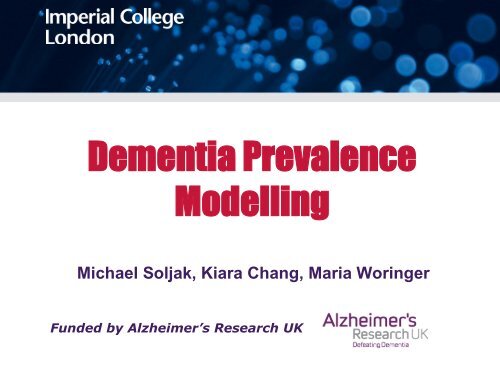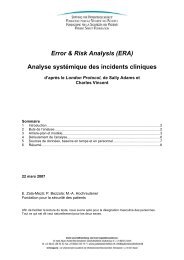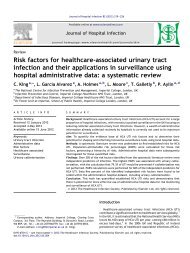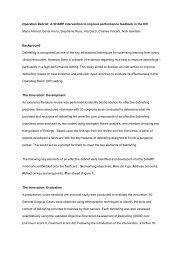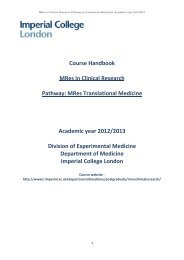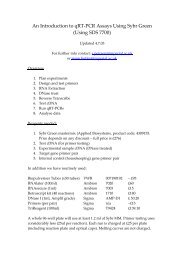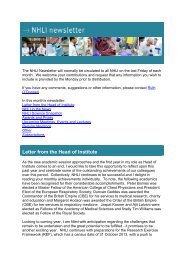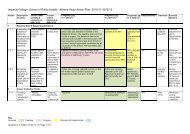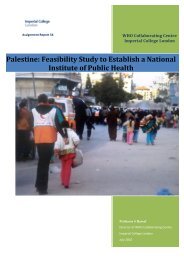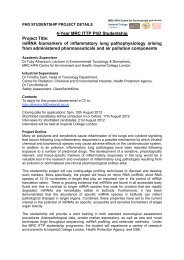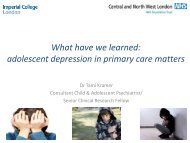PowerPoint - Imperial College London
PowerPoint - Imperial College London
PowerPoint - Imperial College London
Create successful ePaper yourself
Turn your PDF publications into a flip-book with our unique Google optimized e-Paper software.
Dementia Prevalence<br />
Modelling<br />
Michael Soljak, Kiara Chang, Maria Woringer<br />
Funded by Alzheimer’s Research UK
Dementia Background<br />
• 792,862 people living with dementia in the UK(1)<br />
• 84% of dementia cases are in England(1)<br />
• Less than half of the people with dementia receive a formal<br />
diagnosis (1)<br />
• Dementia is more common in women than in men(1)<br />
• Dementia costs £23 billion a year (2)<br />
• Dementia affects around 5% of the over 65s, rising to 20% of<br />
the over 80s.(3)<br />
• Number of dementia cases in the UK will double in 30 years<br />
and the national cost will be over £50 billion per year (4)<br />
Sources: Alzheimer’s Society (2012) (1)“Dementia, A National Challenge” (2) “Mapping the Dementia<br />
Report 2012” ; (3) NICE COF Briefing Paper (2011) (4) UK National Dementia Strategy (2009)
Disparities in Screening in North and South<br />
% People with Dementia<br />
Diagnosis (2012)<br />
44% England, 39% Wales, 63%<br />
N. Ireland, 64% Scotland<br />
Source: BBC News Health, January 15, 2013<br />
http://www.bbc.co.uk/news/health-21009458<br />
Dementia Map: Alzheimer’s Society
GP Registered vs. Estimated Dementia Prevalence in England<br />
700000<br />
600000<br />
500000<br />
400000<br />
300000<br />
200000<br />
100000<br />
0<br />
2007 2008 2009 2010 2011 2012<br />
Registered<br />
Estimated<br />
Sources: Registered: QOF data. Estimated: Alzheimer’s Society (2012) “Mapping the Dementia<br />
Report 2012”, “2007 Dementia UK Report”
Prime Minister’s Challenge on Dementia<br />
“We will ensure that GPs and<br />
other health professionals<br />
make patients aged 65 and<br />
older aware of memory<br />
clinics and refer those in<br />
need of assessment.<br />
From April 2013, there will be a<br />
quantified ambition for<br />
diagnosis rates across the<br />
country, underpinned by<br />
robust and affordable local<br />
plans”<br />
Prime Minister, March 26 2012
Open Letter to the BMJ 27.12.12<br />
Challenges to Screening<br />
Lack of evidence for the established criteria for screening such<br />
as availability of an effective treatment or intervention. Do the<br />
benefits outweigh any potential harm of screening?<br />
NICE Clinical Guideline 1.3.1.1 (2011)<br />
General population screening for dementia should not be<br />
undertaken.<br />
National Screening Committee (2010)<br />
Screening for Alzheimer’s disease should not be offered.
Planned model development & project objectives<br />
Original Study Objectives<br />
• Develop prevalence models for medium to high risk<br />
cognitive impairment and dementia<br />
• Evaluate model performance<br />
• Validate the models using an external data source<br />
• Apply the models to the general practice and MLSOA<br />
populations<br />
Future Application<br />
• Does targeted case-finding meet National Screening<br />
Committee criteria?
Individual At Risk<br />
Modelling<br />
• Model that predicts the risk of<br />
an outcome for an individual<br />
• Most individual risk prediction<br />
models are poor at<br />
discriminating at risk<br />
individuals for dementia from<br />
non at risk cases.<br />
Dementia Modelling<br />
Population Prevalence<br />
Modelling<br />
• Model that predicts the<br />
prevalence of an outcome in a<br />
given population<br />
• Delphi Consensus<br />
• Alzheimer’s Society 2011-<br />
2012 Estimates<br />
• Dementia Prevalence<br />
Calculator
Background of<br />
English Longitudinal Study of Ageing (ELSA)<br />
• Representative sample of people aged 50+ in England<br />
• ELSA sample drawn from households responding to Health Survey for<br />
England (HSE) in 1998, 1999 and 2001<br />
• ELSA wave 1 survey started in 2002, it is a longitudinal study with 4<br />
waves (02’-03’, 04’-05’, 06’-07’ 08’-09’)<br />
• Overall 16,624 people responded in 1 or more ELSA waves<br />
• We chose 8,134 people whose age are 64+ (46% male, 98% white)<br />
• 243 (2.98%) out of 8,134 people have self/proxy reported doctor<br />
diagnosed dementia, and 120 of the dementia cases were reported by<br />
proxy informant<br />
• 42 (out of 8,134) people were interviewed in an institution (care home),<br />
and 41 of those have reported dementia
Outcome measure in ELSA:<br />
self/proxy reported doctor-diagnosed dementia<br />
Studies in literature use one of the criteria as the outcome “Clinical<br />
dementia diagnostic” : CAMDEX, ICD-10, DSM-IV and NINCDS<br />
DSM-IV (Diagnostic and Statistical Manual of Mental Disorders)<br />
Diagnostic Criteria of Dementia<br />
• Memory impairment. e.g. To recall the information after a delay of several<br />
minutes<br />
• Disturbances in executive functioning - the ability to think abstractly and to<br />
plan, initiate, sequence, monitor. E.g. State as many animals as possible in 1<br />
minute<br />
• Agnosia - Failure to recognize or identify objects<br />
• Apraxia - Impaired ability to execute motor activities. E.g. combing hair<br />
• Aphasia - Deterioration of language function. E.g. To repeat phrases “no ifs,<br />
ands, or buts”<br />
• Memory impairment and cognitive function decline must be severe<br />
enough to cause a significant decline in social or occupational<br />
functioning and must show a decline from previous functioning<br />
CAMDEX=Cambridge Mental Disorders of the Elderly Examination. ICD-10=International<br />
Classification of Diseases. NINCDS=National Institute of Neurological Disorders and Stroke
Outcome measure in ELSA:<br />
self/proxy reported doctor-diagnosed dementia<br />
• DSM-IV (Diagnostic and Statistical Manual of Mental Disorders,<br />
Fourth Edition) Diagnostic Criteria<br />
0<br />
1<br />
0<br />
1<br />
Box plot of Animal Naming score<br />
0 = Non-demented, 1 = Demented<br />
0 10 20 30 40 50<br />
Animal naming score<br />
Box plot of Delayed recall task score<br />
0 = Non-demented, 1 = Demented<br />
0 2 4 6 8 10<br />
Delayed recall score<br />
0<br />
1<br />
0<br />
1<br />
Box plot of Letter cancellation task score<br />
0 = Non-demented, 1 = Demented<br />
0 20 40 60<br />
Letter cancellation task score<br />
Box plot of Self-rated Memory<br />
0 = Non-demented, 1 = Demented<br />
1 2 3 4 5<br />
Self-rated Memory<br />
1= poor, 2=fair, 3=good, 4=very good, 5=excellent
Dementia model construction in ELSA<br />
• Covariates not used because missing too much<br />
• Fruit intake, Total cholesterol, High density lipoprotein (HDL), HRT (only exist for<br />
women)<br />
• Covariates not used because not available locally<br />
• Alcohol consumption, Parkinson’s disease, self-rated memory<br />
• Other dropped covariates<br />
• Ethnicity (99% white), Education (too many people have no qualification), Have<br />
any children<br />
• Covariates used: age, gender, self-rated health, depression, smoking<br />
status, living with spouse, BMI, high blood pressure, diabetes, stroke, and<br />
NS-SEC8<br />
• Multiple imputation by chained equations (ICE)<br />
• Uni-variate logistic regression<br />
• Multi-variate logistic regression
Final ELSA Multivariate Model: Results<br />
Variable OR p-value 95%CI<br />
Age(banded) 65-69 1.000<br />
70-74 2.577 0.001 1.454 4.569<br />
75-79 5.715 0.000 3.294 9.917<br />
80-84 16.418 0.000 9.935 27.130<br />
85-89 30.576 0.000 18.048 51.799<br />
90+ 50.042 0.000 26.782 93.504<br />
Female 0.900 0.478 0.675 1.202<br />
Depression 5.971 0.000 3.025 11.788<br />
Diabetes 3.032 0.000 1.899 4.840<br />
Stroke 3.707 0.000 2.615 5.255
Sensitivity<br />
Model Assessment in ELSA:<br />
Is Our Final Model Better than Age & Sex only Model?<br />
0.00 0.25 0.50 0.75 1.00<br />
0.00 0.25 0.50 0.75 1.00<br />
1-Specificity<br />
(1) Age&Sex ROC area: 0.8184<br />
Reference<br />
(2) Final ROC area: 0.866<br />
ROC comparison AUC S.E. 95% CI Prob>chi2<br />
Model 1 Age&Sex 0.8184 0.014 0.791 0.845 0.0000<br />
Model 2 Final 0.8660 0.012 0.842 0.889
0<br />
1<br />
Model diagnostic in ELSA:<br />
How well does the model predict the data?<br />
Box plot of Predicted Probability<br />
0 = Non-demented, 1 = Demented<br />
0 .2 .4 .6 .8 1<br />
predicted probability of being dementia case<br />
Sensitivity = Pr(+ve| case)<br />
Specificity = Pr(-ve | non-case)<br />
Sensitivity/Specificity<br />
0.00 0.25 0.50 0.75 1.00<br />
Probability cut-off = 0.025<br />
Sensitivity = 79.84%<br />
Specificity = 79.64%<br />
Sensitivity/Specificity v.s. probaility cutoff<br />
0.00 0.25 0.50 0.75 1.00<br />
Probability cutoff<br />
Sensitivity Specificity
Model diagnostic in ELSA:<br />
How well does the model predict the data?<br />
Compare dementia ELSA Reported ELSA<br />
casesness<br />
dementia Non-demented Total<br />
Predicted demented 198 1607 1805<br />
Predicted non-demented 45 6284 6329<br />
Total 243 7891 8134<br />
• Sensitivity = Pr(+ve|case) = 198/243 = 81.4%<br />
• Specificity = Pr(-ve | non-case) = 6284/7891= 79.6%<br />
• This coincides with what we expected to get<br />
• The AUC for this model is 0.8660 (0.842, 0.889)<br />
• This multi-variate model has done well in predicting the outcome
External comparison: ELSA vs. CFAS<br />
List ELSA (2002-2009) CFAS(1991-1997)<br />
Population England 64+ England & Wales 65+<br />
Waves 1 to 4 2 & 3<br />
No. demented 243 277<br />
Controls 7891 3800<br />
Education 25% A level+ 36% 10 years+<br />
Ethnicity 99% White 73% White<br />
Institutionalized 42(0.52%) 710(5.6%)<br />
Dementia definition<br />
Self reported doctor<br />
diagnosed<br />
CFAS = Cognitive Function Study of Ageing<br />
No diagnosis, GMS & AGECAT<br />
algorithm(score 3-5)
ELSA Final 5 Variables CFAS Final 7 Variables<br />
Age Age<br />
Sex Sex<br />
Depression Wave<br />
Diabetes Education<br />
Stroke Self-rated health<br />
Stroke<br />
Live in institution<br />
External comparison: ELSA vs. CFAS<br />
Model Specification AUC Std. Err. 95% CI<br />
1 ELSA Age&Sex 0.8184 0.0140 0.7910 0.8458<br />
2 ELSA Final 0.8792 0.0121 0.8554 0.9030<br />
3 CFAS Age&Sex 0.7541 0.0141 0.7265 0.7820<br />
4 CFAS Final 0.7759 0.0132 0.7499 0.8020<br />
Sensitivity<br />
0.00 0.25 0.50 0.75 1.00<br />
ELSA versus CFAS ROC comparison<br />
0.00 0.25 0.50 0.75 1.00<br />
1-Specificity<br />
(1) ELSA Age&Sex (2) ELSA Final<br />
(3) CFAS Age&Sex (4) CFAS Final<br />
Reference
How Do Our Findings Compare with the Literature?<br />
Prevalence of Dementia According to ELSA, Delphi Consensus (2007) and MRC CFAS (1998)<br />
35.0%<br />
30.0%<br />
25.0%<br />
20.0%<br />
15.0%<br />
10.0%<br />
5.0%<br />
0.0%<br />
65-69 70-74 75-79 80-84 85-89 90+<br />
ELSA<br />
Delphi<br />
CFAS
Consistencies with the Literature<br />
• Strong systematic review evidence of diabetes, depression<br />
and stroke being predictive of dementia.<br />
• ELSA OR were significantly higher than the pooled odds<br />
ratios reported in systematic reviews<br />
• Diabetes OR=1.5(1)<br />
• Diabetes OR=3.03 (1.89-4.84) in ELSA<br />
• Depression OR = 2.30 (1.71-3.09) with diagnostic dementia criteria, OR=1.91 (1.62-<br />
2.26) without (2)<br />
• Depression OR=4.57 (1.03-1.85) 1 year before onset of AD; OR=1.71 (1.03-2.82)<br />
>25 yrs before onset of AD (3) in a study not using formal criteria for dementia &<br />
depression<br />
• Depression OR=5.97 (3.03, 11.79) in ELSA<br />
• Stroke OR=2.0 (4)<br />
• Stroke OR=2.2 (1.6-3.0) with previous stroke, OR=1.7 (1.1-2.5) w/ multiple strokes (5)<br />
• Stroke OR = 3.71 (2.62, 5.26) in ELSA<br />
References: (1) Kloppenborg et al(2008); (2) Ownby RL (2006);<br />
(3) Green RC (2003); (4) Savva (2010) et al; (5) Pendlebury ST (2009)
Inconsistencies with the Literature<br />
• Sex was not significant<br />
• Living with spouse was found to be a significant risk<br />
factor for dementia<br />
• Self-rated health was significant univariately but not<br />
in a multi-variate model<br />
• While current smoking was not significant, exsmoking<br />
adjusted by age and gender was a<br />
significant protective factor in ELSA
Conclusions / Recommendations<br />
• ELSA model over predicts dementia in over 65s<br />
(20% vs. patient / proxy reported 3%)<br />
• ELSA model correctly identifies 80% of reported<br />
dementia cases and 80% of non-demented cases<br />
• Does the combined risk factor profile of depression,<br />
diabetes, and stroke helps to identify more<br />
dementia cases in over 65 at the GP level?<br />
• Option 1: Apply the model to all local population<br />
data and disseminate our findings via DH<br />
• Option 2: Apply the model to selected local<br />
populations for targeted case-finding R&D study


